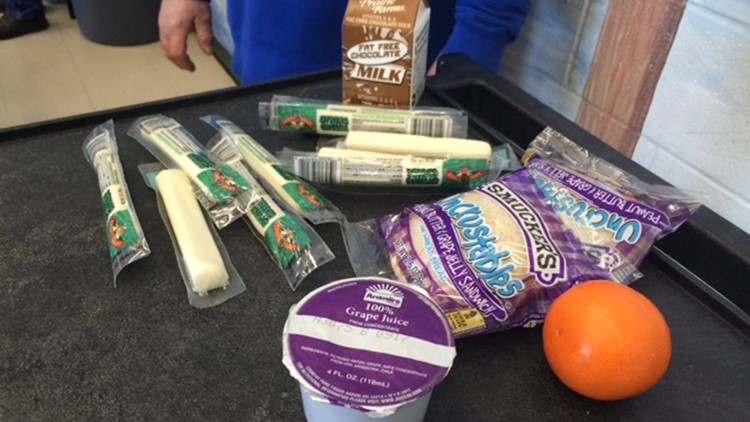There's a food fight going on in school lunchrooms across Indiana.
It's a fight to save millions of untouched, perfectly good food items, that right now are getting trashed by students who choose not to eat them.
Every day at Maple Ridge Elementary in Madison County, you can't miss the sound in the lunchroom. It's a bright and boisterous cafeteria, with hand-painted murals on the walls and tables full of talkative students.
It's also where custodian Dave Ward launched his second career.
"I love the kids," Ward said with a smile. "I really do. I worked in a different field for 30 years."
Now, every 30 minutes, Dave cleans up after students who line up and load up on soups, sandwiches and sides, along with a generous helping of laughter and friendship. That socializing sometimes puts lunch on the back burner.
"If you sit and watch a lunchroom, they're talking to their friends. They're trying to hurry and get out to go to recess. We only have 30 minutes for lunch period, so by the time they get their food, 20 minutes can fly by pretty quickly," said South Madison Community Schools' Director of Nutrition Services, Lindsey Hill.
In fact, about a year ago, Dave Ward noticed something - a lot of uneaten food that was going from tray to trash.
Some of it was barely touched.
Some of it was not even opened.
"We have milk, oranges, apples, peanut butter and jelly and string cheese," Ward pointed out. "There's a lot of waste."
He saw food going in the garbage over and over and over again. Hundreds of items were just thrown away each day.
"I was really, really shocked. I just could not believe we'd be throwing away unopened food, milk, you name it," Ward said. "At my other school, we averaged 250 cartons of milk wasted a week. That's a lot of milk!"
"You know, we want the kids to eat everything on their tray, but sometimes, for one reason or another, they just don't want everything that's on their tray," Hill said.
The amount of waste is staggering.
An estimated 22 million unopened, unpeeled food items are thrown away each year in Indiana school cafeterias. The numbers skyrocket to an estimated one billion nationwide. That's like filling Lucas Oil Stadium, from top to bottom, every day with food waste.
"After you see so much of that going into the trash, you start asking questions," Ward said. "There are a lot of needy people who could use that food."
So Ward took action to fix it, contacting the nutrition director and the superintendent with a plan.
"Dave found Food Rescue and said 'Well, Lindsey, what about this group?' I said, 'That sounds awesome'," Hill said. "I said we're happy to prepare the food for someone to take it. We just need the volunteers to come and pick it up. It takes just as much time to package the food up, ready for somebody to take it as it does to put in the garbage disposal or in the trash."
Now, caring agencies receive the unopened cafeteria food, like Grace Care Center's food pantry in Carmel. It's feeding people in need, not a landfill.
John Williamson created K-12 Food Rescue to help the hungry and the environment.
"We just feel like it's a tragedy that when kids walk by the trash can, they don't have a better choice than having that food end up in a landfill. It seems there's a much better use for this food," Williamson said.
So far, 213 Indiana schools are involved in Food Rescue. That's the highest percentage of school participation in a food waste recovery program of any state in the country and Food Rescue is currently actively recruiting more schools.
"The answer is to teach a generation of children that are in schools that they can make a better choice than throwing food in the trash, because food is not trash," Williamson said.
At Maple Ridge, there's now a cart for Food Rescue, right by the trash can.
Kids say it's easy.
"Like milk or something like this, if you don't open it, then you put it over there and they'll reuse it, like for the food bank," explained sixth grader Berkeley Lord.
Staffers then simply save the unopened or unpeeled items and store them in a cooler. Volunteers with local pantries take care of the rest.
A similar solution to food waste is playing out on college campuses. As part of the Food Recovery Network, Butler University students collect uneaten concessions after basketball games so they're not trashed.
"We get all this food after the end of the day at the dining halls or at the basketball games and we just pack it all up and take it to the Julian Center," explained Butler junior Olivia Carroll.
Pretzels, popcorn, even hot dogs can go, since they're taken to the charity right away.
"I'm overwhelmed with how much food we have today," one student said after a recent basketball game. "We have three pounds probably just at one concession stand at one university."
Students say they've donated hundreds of pounds to the Julian Center just in the past year.
At Harrison High School in Tippecanoe County, you literally can see their strategy to reducing food waste.
"It's about color, presentation and location," said Lori Shofroth, Harrison High's Director of Nutrition.
Their lunchroom recently had a remodel that looks more like a mall food court than a cafeteria. There are wood floors, clean lines with stainless steel and modern signage and lighting. The ambiance is almost psychological and that's the point.
They believe kids will eat with their eyes.
"Because if it looks good, the kids will try it and once they usually try it, they enjoy it and they'll continue to come back," Shofroth explained.
There's also a focus on choice: international foods, grab-and-go, homestyle and a creation station, that lets student design their own sandwiches, much like a Subway or deli restaurant.
It's working.
Staff at Harrison says consumption is way up, even fruits and veggies.
"They are going through at least four cases of apples a day minimum," Shofroth said.
Presentation is certainly not part of the solution at Beech Grove Middle School.
But it's another way to reduce waste that's working. Beech Grove has a composting facility in the backyard of the building. It may not look appetizing, but they're turning food waste into fertilizer.
"This brown right here is our worm compost," explained Beech Grove Ag/Science teacher Sam Lawrence. "They dump school lunch waste and there's a layer of worms underneath that will rise up and feed on that food waste. Compost comes out the bottom and we just scoop it out and we shovel."
The compost is used to grow gardens at the school. Students eventually will eat strawberries from the garden beds, which are fertilized by what they didn't eat in the cafeteria.
"We collect anywhere from 17-50 pounds of waste, depending on what's being served at lunch on an average day," Lawrence said.
They're all different ways of making school lunch what it's supposed to be - eaten - whether by kids in the cafeteria or elsewhere.
It means a lot to custodian Dave Ward, who no longer has to watch perfectly good food go to waste.
"It's not eaten here, but it will be eaten by someone that needs it," Ward said. "So that's a good thing."
School leaders say there's an added benefit to the Food Rescue program. They're now able to track and keep a tally of food that would have gone in the trash. That new data helps them plan better menus.
For example, if they thought something was popular, but it's actually being thrown away, now they can put something different on the menu that kids will actually eat, while staying within nutritional guidelines.
More information
Plate Waste: Information from the USDA about plate waste and ways to combat it, including the Food Waste Challenge. The national goal is to reduce food waste by 50% by 2030.
K-12 Food Rescue: What's in lunchroom trash, how to get your child's school involved in recovering food for local pantries.
Food Recovery Network: Colleges reducing food waste, including Butler University and the University of Indianapolis.



